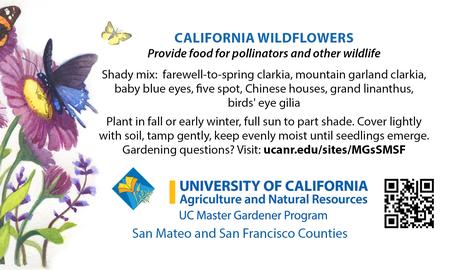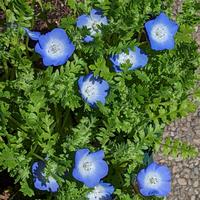Gardening with California Native Wildflowers
 Wildflower Seed Packet
Wildflower Seed Packet

You may have been given one of these seed packets at a class, a farmer's market or other Master Gardener event. This packet contains a mix of wildflowers that do well in sun or part shade, including flowers such as (see this list for details): baby blue eyes (Nemophila menziesii), bird's eye gilia (Gilia tricolor), Chinese houses (Collinsia heterophylla), elegant clarkia (Clarkia unguiculata), farewell-to-spring (Clarkia amoena), fivespot (Nemophila maculata), grand linanthus (Linanthus grandiflorus), punchbowl godetia (Clarkia bottae).
How to plant: Moisten the soil and scatter the seeds on the surface. The seeds need sunlight to grow, so barely cover them with a very thin layer of potting mix or compost. This packet will plant a large pot or about a 2'x2' area of soil.
Introduction

California native plants are uniquely adapted to support local wildlife, including bees, butterflies, and birds, while adding natural beauty to your garden. Discover how to create a thriving, sustainable landscape on our California Native Gardening page.
Benefits:
- Attracts and supports wildlife (see Why natives?)
- Colorful, long season
- Low maintenance, self sows
- Good in containers
- Great fill-in plants: If you recently planted an area, you may have widely-spaced plants that look a little forlorn. Fill in between with low-growing annuals, and you'll have color and interest while the perennials grow to their full size.
Choosing wildflowers
There are hundreds of wildflowers native to our area. Using Calscape.org, the online CA native plant tool, you can find annuals that will do well in your area and support local wildlife. Search using your address, zip code or city to find local native plants.
If you're not sure what you want, try a wildflower mix. Mixes are designed to have compatible needs (such as full sun or shade) and to give a long season of bloom. Or if you get individual varieties, rather than a mix, you can plant swaths of individual species to form a design.
Local nurseries may have wildflower seeds available and sometimes transplants as well. There are online sources for seeds that usually have a larger selection than you'll find in stores. Just like when shopping for vegetable seeds, if you want a specific variety you may need to search a little farther afield.
Be aware that some wildflower mixes have flowers that are not California wildflowers and may even have flowers that are invasive to California. Be sure it's labeled as containing only California wildflowers.

Growing
Many wildflowers grow well in containers as well as in the ground. Most should be planted during fall or winter, through February in our area. Wait to plant until our winter weather pattern has begun, with its periodic rainfall and cool temperatures.
Thinking about planting in a container? Here are a few considerations:
- Pros
- No weeds.
- Great soil and drainage.
- Easier to protect from predators.
- No open ground? No problem!
- Cons
- Needs to be watered.
- May need some fertilizer (because the potting mix doesn’t have the same soil microbes).

Preparation
- In ground:
- Clear the area by removing weeds, lawn and other plants. For extremely weedy, lawn, or compacted areas, sheet mulch to kill existing weeds/lawn and improve the soil (see these resources for details). Important: do not use herbicides as they are likely to affect the seedlings.
- Remove mulch.
- Dig down to be sure the soil in the top few inches is moist. If not, water until it is.
- Rake the soil to rough it up, and remove large rocks.
- In a container:
- Choose a large container with drainage holes, 12-18” across and deep, at least.
- Place the container so it will be sure to drain freely.
- Fill the container with a well-draining planting mix (not garden soil). Try to find a mix that does not have fertilizer or only has organic fertilizer. Thoroughly moisten the mix in the container.
Planting
- Many natives are surface-sown, unlike most vegetables seeds that are inserted ¼ - 1” underground. (Exception: large seeds like some lupines: rake in lightly after sowing. Sow small seeds after the big ones are in place.)
- Take a pinch of seed and drop seeds evenly over the area. To make it easier to spread small seeds evenly, thoroughly mix the seed with a handful of potting mix, compost or vermiculite ("fine" grade, about 1/8") and sprinkle that over the area.
- Some recommend spreading a single layer of horticultural pumice (about ¼" diameter) over the seedbed before sowing the seeds. The idea is that the seeds will fall down between the stones and will be protected from birds and weather. The gravel can also help prevent the seeds from washing away due to heavy rain.
- Sprinkle a light layer (< ¼”) of compost or potting mix over the area. You want sunlight to reach the seeds. This layer will help retain moisture, keep the seeds from blowing away, and hide them from critters.
- Lightly water the area to help ensure the seeds are in good contact with the soil. Use a fine spray or mist, or the seeds will be washed away.
- If you want to keep the critters away, you may want to cover the area with a loose layer of branches/twigs, wire mesh, or floating row cover. You need to let light, water and air in while keeping the critters out.

Maintaining
- Keep the area moist using a fine spray. If we have a good rainy season, this may not be necessary. Check nearby soil to decide if additional water is needed.
- Watch for new plants coming up. Take your time before pulling “weeds,” until you’re sure what they are. Some plants have seed leaves that look like grass, but the second (“true”) leaves look more like the mature plant.
- Especially in containers, watch the new plants to see if they appear healthy. If you start to see some yellowing leaves, apply an organic fertilizer following the label directions.
References
- Seed Propagation of Native California Plants, by Dara E. Emery
- California Native Gardening, A Month-by-Month Guide, by Helen Popper
- Growing California Native Plants, by Marjorie G. Schmidt
Author: Cathrin Callas, UC Master Gardener Volunteer
Photos by author unless otherwise noted.
Revised: 10/19/2024
